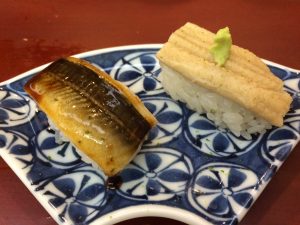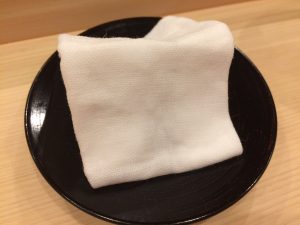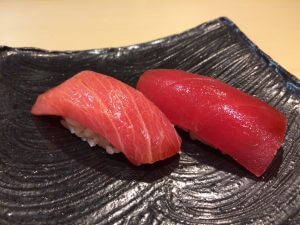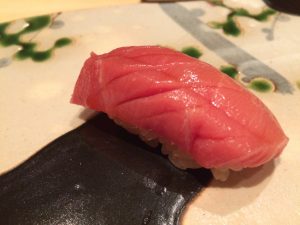Have you ordered Nigiri-sushi and been served two pieces on one plate?
There are multiple theories as to the reason for this, but the most likely one is as follows.
The reason sushi is served in sets of two pieces is that this practice is left over from long ago (the Edo period), when pieces of sushi were made large, like onigiri, and difficult to eat. At some point (it’s unclear when), these were just cut in half, making two pieces that led to what we see today (there are multiple theories about when this happened).
However nowadays, if you were to eat two pieces of each topping, you won’t be able to enjoy as many different kinds, so customers sitting at the counter are served only one piece at a time. So then why do other restaurants continue to prepare two pieces at once? This may be in order to improve the efficiency of the sushi chef’s work. Also, regular customers may see toppings others are ordering and ask for the same one. This helps reduce the workload of the sushi chef.

But there are also some toppings that are better to eat in pairs.
For example, conger eel tastes completely different when one piece is eaten with salt and the other seasoned with sweet sauce. Serving the part of the eel closer to the head skin-up and the part closer to the tail belly-up also offers different textures; skin-up offers a smooth texture while belly-up offers a fluffy texture. In addition, the head and tail simply taste differently. Since the back and belly of fish like bonito and mackerel have different fat content, it can be better to order two pieces at a time in order to fully experience each of the individual qualities of the fish.
[sc_apply url=”https://sushiuniversity.jp/apply/”]
We hope this information will be helpful.

Revision date: March 27, 2023
Share this article
 Many overseas visitors who aren’t used to eating fish have an aversion to
Many overseas visitors who aren’t used to eating fish have an aversion to  Sushi was originally a food eaten with your hands. Even, for example, if you are in a prestigious sushi restaurant in Ginza, you can still eat with your hands. You can actually use your hands to eat the ginger too. Restaurants that prefer you to eat with your hands will provide an extra,
Sushi was originally a food eaten with your hands. Even, for example, if you are in a prestigious sushi restaurant in Ginza, you can still eat with your hands. You can actually use your hands to eat the ginger too. Restaurants that prefer you to eat with your hands will provide an extra, 
